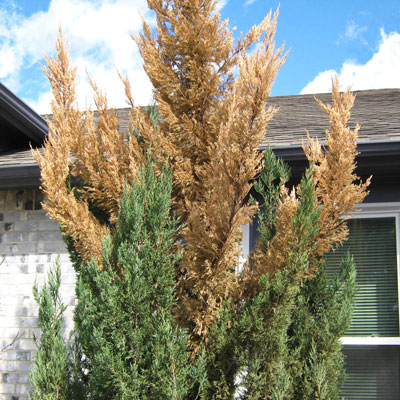Question of the Week #2: August 18, 2016
“Neil, I’m losing big parts of my juniper. What causes this, and what can I do to stop it?”
This has become almost epidemic in North Texas where I live and garden. These upright junipers are used to anchor entryways and corners of houses. And then tips and entire branches fade from dark green to metallic dull green to brown in just a matter of a couple of weeks.

A Facebook reader posted this graphic example of juniper twig blight to my page earlier this year.
Pruning tall plants like this would leave them disfigured, and there is no assurance that the fungus hasn’t already spread to other seemingly healthy branches.
To the best of my knowledge, this is Phomopsis twig blight. However, other blight funguses also attack these upright junipers, as you can see in this information from Penn State.
Your best bet in the long run may be to avoid planting Blue Point and Spartan junipers (and perhaps a few others). Somewhat upright hollies like Oakland fill very much the same forms, plus they’re happy in both sun and shade. (Junipers must have sun.) To note: I have never seen this bother eastern redcedar, Ashe and other native junipers significantly.
If you already have Blue Point or Spartan junipers, however, watch for any signs of this problem. At first evidence, prune out the damaged growth entirely, then spray the rest of the plant with a fungicide that’s labeled for twig cankers.
Although I have experienced this on two lovely Spartan junipers I had 15 years ago, one at our home and one at my office, I admit to not being an expert on it. But then again, it appears that even the pathologists group several of these problems together, so that tells you that the diagnosis may not be clear-cut.
The most precise information would come after you send samples to the Texas Plant Clinic at Texas A&M. There is a fee to have them culture your plant samples for their diagnosis. Here is a link to the website.
